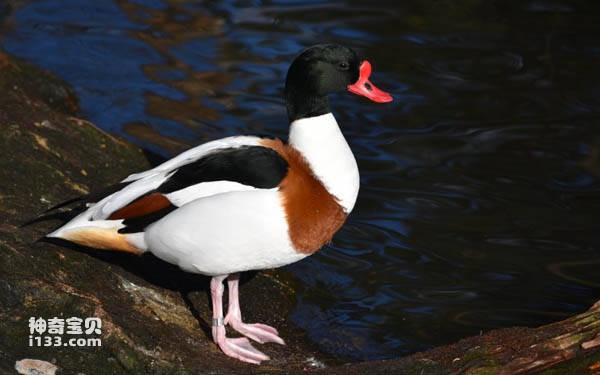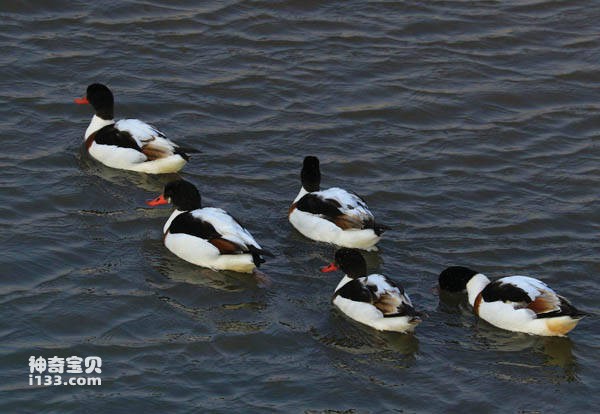Tadorna tadorna
IUCN
LCBasic Information
Scientific classification
- name:Tadorna tadorna
- Scientific Name:Tadorna tadorna,Common Shelduck
- Outline:Waterfowl
- Family:
Vital signs
- length:52-63cm
- Weight:500-1750g
- lifetime:About 16 years
Feature
The body feathers are mostly white, the head and upper neck are black, with green luster, and the mouth is turned upward and red
Distribution and Habitat
Place of origin: Afghanistan, Albania, Algeria, Armenia , Austria, Azerbaijan, Bangladesh, Belarus, Belgium, Bhutan, Bosnia and Herzegovina, Bulgaria, China, Croatia, Cyprus, Czech Republic, Denmark, Egypt, Estonia, Finland, France, Germany, Greece, Hong Kong, Hungary, Iceland, India, Islamic Republic of Iran, Iraq, Ireland, Israel, Italy Italy, Japan, Jordan, Kazakhstan, Republic of Korea, Republic of Korea, Kuwait, Kyrgyzstan, Latvia, Lebanon, Libya, Lithuania, Macedonia, Malta, Moldova, Mongolia, Montenegro, Morocco, Netherlands, Norway, Oman, Pakistan, Palestine, Poland, Portugal, Qatar, Romania, Saudi Arabia, Serbia , Slovakia, Slovenia, Spain (Canary Islands), Sweden, Switzerland, Syrian Arab Republic, Tajikistan, Tunisia, Turkey, Turkmenistan, Ukraine, United Arab Emirates, United Kingdom, Uzbekistan, Yemen.
Travellers: Bahrain, Ethiopia, Ghana, Gibraltar, Guinea-Bissau, Lao People's Democratic Republic, Liechtenstein, Luxembourg, Mauritania, Myanmar, Nepal, Philippines,
Appearance
Male head and upper neck black brown, with green luster; The lower neck, back, waist, tail cover and tail feathers are all white, and the tail feathers have black stripes. The shoulder feathers and the primary feathers are black brown, and the secondary feathers are metallic green, forming an obvious green wing mirror on the wings; Three tiers of flight feathers outside chestnut, wings covered with white feathers; There was a broad maroon girdle from the upper back to the chest; There is a dark brown longitudinal band in the middle of the chestnut-colored ring that extends backward through the abdomen to the perianal; Undertail cover brown white, the rest of the underbody white. The mouth is red, with a prominent red cortical tumor at the base of the upper mouth during the breeding season. The female has lighter plumage than the male. There is no green metallic luster on the head and neck, a small white spot on the forehead, a narrow brown-chestnut chest band and a faint black longitud
Details
The Common Shelduck (Tadorna tadorna) is a large duck with no subspecies.

In early March, the ducks began to leave the wintering ground and move to the northern breeding ground. They arrived at the breeding ground in northeast China from early April to mid-April, and at the breeding ground in northwest China from late April to early May. Autumn begins to leave the breeding ground for the wintering ground in late September, and reaches the southern wintering ground from late October to early November. The migration route is mainly carried out along the coast and rivers, constantly stopping and foraging, especially in the Shuangtaizi estuary area of Liaoning Province, during the spring and autumn migration every year, there are thousands of warping nose duck migrate here and stop here for a long time.
The duck mainly feeds on aquatic insects, insect larvae, algae, mollusks, snails, oysters, sea snails, sand worms, leeches, lizards, locusts, crustaceans, land insects, small fish and fish eggs, as well as plant foods such as plant leaves, buds and seeds.

Ducks like to live in groups, especially in winter, often in large groups of dozens to hundreds of birds, and live in pairs during breeding. The flight is fast, the wings flap fast. Good at swimming and diving, also good at walking, can run briskly on the ground. Sex alert, often constantly stretch the neck to look around, 100 meters away from people that take off.
The ducks reached sexual maturity at 2 years of age. Pairs are usually formed during wintering, but sometimes during migration and after arrival at breeding grounds. Mating takes place in water and sometimes on land. Breeding season May to July. Nests are built between sand dunes or stone walls on the coast and lakes, and sometimes in natural caves on open grasslands or abandoned burrows of animals such as foxes and rabbits. Some caves are as deep as 4 meters. The nest is disc-shaped, mostly composed of grasses, grasses, bird bones and fish bones, and is padded with a large number of feather feathers. The nest is 8 cm high and 6 cm deep, with an inner diameter of 17.5 cm and an outer diameter of 26 cm. Each clutch lays 7-12 eggs, usually 8-10, and the eggs are oval, pale yellow or cream white and are 62-70 mm x 42-51 mm in size. It weighs 69-78 grams. Usually 1 egg a day, after the production of the last egg, the egg begins to incubate, borne by the female bird alone, the male bird near the nest guard, when there is danger, the male bird immediately issued an alarm call, while flying to the nest. When female birds leave the nest to forage for food every day, they often cover their eggs with feathers, even when brooding in relatively deep holes. During the last two days of incubation, the female does not leave the nest, incubating for 27-29 days. Young birds early sex, soon after hatching can be active, while walking out of the nest alone, under the lead of the parent bird into the water activity. The chicks are able to fly after a little more than a month, but remain with their parents until the following spring.

The population of Cocked duck in China has always been very rich, and it is one of the main hunting objects in China. However, their populations have not been specifically surveyed in the past. According to the Asian waterbird survey organized by the International Waterfowl Research Bureau in 1990, there were 19,188 in China, 475 in Japan, 177 in South Korea, 359 in Bangladesh, 656 in India, and 416 in Pakistan, totaling about 25,000 in Asia. In Europe there are 130,000. The total population of the world is about 150,000.
In October 2020, the State Forestry and Grass Administration issued the Notice on Regulating the Scope of Classified Management of fasting Wild Animals, prohibiting breeding activities for the purpose of eating the animals, and guiding farmers to stop breeding except for special circumstances such as the retention of appropriate provenance.
Listed on the International Union for Conservation of Nature (IUCN) 2016 Red List of Threatened Species ver 3.1 - Not Threatened (LC).
It was included in the List of Beneficial Terrestrial Wildlife under State Protection or of Important economic and scientific research Value issued by the State Forestry Administration of China on August 1, 2000.
Protect wild animals and eliminate wild meat.
Maintaining ecological balance is everyone's responsibility!








